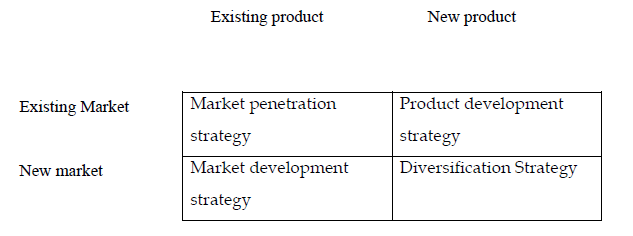
1. Market Penetration Strategy.
Current products in current markets
- Maintain or to increase its share of current markets..
- Secure dominance of growth markets
- Increase usage by existing customers
- Convert non- user
2. Market Development Strategy
Present products in new markets. The firm seeks new markets for its current products. Market development is chosen if the manager feel that the existing products will not be well received by new customer groups. Its involves;
- New geographic areas
- Different package sizes
- New distribution channels
- Differential pricing policies
3. Product Development Strategy
This involves launching of new product to existing markets. This forces competitors to innovate and new corners are discouraged. It is expensive and risky. Product development is chosen if they feel that the firms existing customers would be interested in products related to its current product lines.
4. Diversification Strategy
The Company makes new products for new markets. There are 2 types of diversification, related and unrelated diversification. Related diversification involves development beyond the present product market but still within the broad confines of the industry. The business moves into areas where there is a true strategic fit with the current business. This takes either horizontal integration or vertical integration.
- Horizontal integration is the developments into activities which are competing with or directly complimentary to the companies present activities i.e. water and electricity.
- Vertical integration-takes a form of either backward vertical integration or forward vertical integration. In backward vertical integration the company becomes the supplier of its raw materials, components or services. In forward vertical integration the company becomes a sale agent or a distributor.
- Unrelated diversification or conglomerate diversification. This involves a business moving into areas where there is no true strategic fit. The management changes attention from the original business.
Titany answered the question on
October 6, 2021 at 12:32